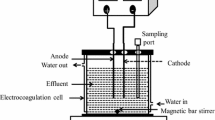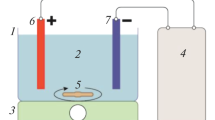Abstract
Cardboard factory wastewater is usually known by high chemical oxygen demand (COD), color, phenols, lignin, and its derivatives, and usual treatment techniques are not able to treat such wastewaters. This study aimed to investigate the efficiency of ozone-assisted electrocoagulation process (EC/O3) for the treatment of real cardboard wastewater. The parameters influencing COD removal in the EC/O3 process were optimized using response surface methodology. Regard to the statistical model, the optimum conditions were obtained at current density 9.6 mA/cm2, time 20 min, and pH 12. At optimal condition, EC/O3 process removed 74.7% and 97.5% of COD and color, which was higher compared to ozonation and EC processes separately. The COD removal followed pseudo-first-order kinetic with the coefficient correlation of 0.97 and the reaction rate constant of 0.073 1/min. To sum up, the combined electrocoagulation process with ozonation could be used satisfactorily for removing pollutants from real cardboard wastewater.








Similar content being viewed by others
Data availability
All data generated or analyzed during this study are included in the manuscript.
References
Abbasi S, Mirghorayshi M, Zinadini S, Zinatizadeh A (2020) A novel single continuous electrocoagulation process for treatment of licorice processing wastewater: optimization of operating factors using RSM. Process Saf Environ Prot 134:323–332
Acharya N, Thakur C, Chaudhari P (2020) Dataset on statistical reduction of COD by electrocoagulation process using RSM. Data in Brief 28:104944
Asaithambi P, Susree M, Saravanathamizhan R, Matheswaran M (2012) Ozone assisted electrocoagulation for the treatment of distillery effluent. Desalination 297:1–7
Asaithambi P, Aziz ARA, Daud WMABW (2016) Integrated ozone—electrocoagulation process for the removal of pollutant from industrial effluent: optimization through response surface methodology. Chem Eng Process Process Intensif 105:92–102
Barhoumi A, Ncib S, Chibani A, Brahmi K, Bouguerra W, Elaloui E (2019) High-rate humic acid removal from cellulose and paper industry wastewater by combining electrocoagulation process with adsorption onto granular activated carbon. Ind Crop Prod 140:111715
Behin J, Farhadian N, Ahmadi M, Parvizi M (2015) Ozone assisted electrocoagulation in a rectangular internal-loop airlift reactor: application to decolorization of acid dye. Journal of Water Process Engineering 8:171–178
Bernal-Martínez LA, Barrera-Díaz C, Solís-Morelos C, Natividad R (2010) Synergy of electrochemical and ozonation processes in industrial wastewater treatment. Chem Eng J 165:71–77
Bilińska L, Blus K, Gmurek M, Ledakowicz S (2019) Coupling of electrocoagulation and ozone treatment for textile wastewater reuse. Chem Eng J 358:992–1001
Camcioglu S, Ozyurt B, Hapoglu H (2017) Effect of process control on optimization of pulp and paper mill wastewater treatment by electrocoagulation. Process Saf Environ Prot 111:300–319
Chen Y, Jiang W, Liu Y, Chen M, He Y, Edem MA et al (2019) Optimization of an integrated electrocoagulation/sedimentation unit for purification of polymer-flooding sewage. J Electroanal Chem 842:193–202
Dalvand A, Gholami M, Joneidi A, Mahmoodi NM (2011) Dye removal, energy consumption and operating cost of electrocoagulation of textile wastewater as a clean process. CLEAN–Soil, Air, Water 39:665–672
David C, Arivazhagan M, Tuvakara F (2015) Decolorization of distillery spent wash effluent by electro oxidation (EC and EF) and Fenton processes: a comparative study. Ecotoxicol Environ Saf 121:142–148
Deveci EÜ, Akarsu C, Gönen Ç, Özay Y (2019) Enhancing treatability of tannery wastewater by integrated process of electrocoagulation and fungal via using RSM in an economic perspective. Process Biochem 84:124–133
Dixit M, Gupta GK, Liu H, Shukla P (2019) Pulp and paper industry based pollutants, their health hazards and environmental risks. Current Opinion in Environmental Science & Health 12:48–56
El-Naas MH, Al-Zuhair S, Al-Lobaney A, Makhlouf S (2009) Assessment of electrocoagulation for the treatment of petroleum refinery wastewater. J Environ Manag 91:180–185
Fallahzadeh RA, Mahvi AH, Meybodi MN, Ghaneian MT, Dalvand A, Salmani MH et al (2019) Application of photo-electro oxidation process for amoxicillin removal from aqueous solution: modeling and toxicity evaluation. Korean J Chem Eng 36:713–721
Farhadi S, Aminzadeh B, Torabian A, Khatibikamal V, Alizadeh Fard M (2012) Comparison of COD removal from pharmaceutical wastewater by electrocoagulation, photoelectrocoagulation, peroxi-electrocoagulation and peroxi-photoelectrocoagulation processes. J Hazard Mater 219-220:35–42
Federation, W.E. & Association, A.P.H. (2005). Standard methods for the examination of water and wastewater. In: American Public Health Association (APHA): Washington, DC, USA
García-Morales M, Roa-Morales G, Barrera-Díaz C, Miranda VM, Hernández PB, Silva TP (2013) Integrated advanced oxidation process (ozonation) and electrocoagulation treatments for dye removal in denim effluents. Int J Electrochem Sci 8:8752–8763
Giannakis S, Vives FAG, Grandjean D, Magnet A, De Alencastro LF, Pulgarin C (2015) Effect of advanced oxidation processes on the micropollutants and the effluent organic matter contained in municipal wastewater previously treated by three different secondary methods. Water Res 84:295–306
Guvenc SY, Erkan HS, Varank G, Bilgili MS, Engin GO (2017) Optimization of paper mill industry wastewater treatment by electrocoagulation and electro-Fenton processes using response surface methodology. Water Sci Technol 76:2015–2031
Katal R, Pahlavanzadeh H (2011) Influence of different combinations of aluminum and iron electrode on electrocoagulation efficiency: application to the treatment of paper mill wastewater. Desalination 265:199–205
Kaur D, Bhardwaj NK, Lohchab RK (2019) Effect of incorporation of ozone prior to ECF bleaching on pulp, paper and effluent quality. J Environ Manag 236:134–145
Klidi N, Proietto F, Vicari F, Galia A, Ammar S, Gadri A et al (2019) Electrochemical treatment of paper mill wastewater by electro-Fenton process. J Electroanal Chem 841:166–171
Mariah GK, Pak KS (2020) Removal of brilliant green dye from aqueous solution by electrocoagulation using response surface methodology. Materials Today: Proceedings 20:488–492
Modirshahla N, Behnajady M, Mohammadi-Aghdam S (2008) Investigation of the effect of different electrodes and their connections on the removal efficiency of 4-nitrophenol from aqueous solution by electrocoagulation. J Hazard Mater 154:778–786
Muniyasamy A, Sivaporul G, Gopinath A, Lakshmanan R, Altaee A, Achary A et al (2020) Process development for the degradation of textile azo dyes (mono-, di-, poly-) by advanced oxidation process - ozonation: experimental & partial derivative modelling approach. J Environ Manag 265:110397
Nanseu-Njiki CP, Tchamango SR, Ngom PC, Darchen A, Ngameni E (2009) Mercury (II) removal from water by electrocoagulation using aluminium and iron electrodes. J Hazard Mater 168:1430–1436
Pormazar SM, Dalvand A (2020). Adsorption of reactive black 5 azo dye from aqueous solution by using amine-functioned Fe3O4 nanoparticles with L-arginine: process optimisation using RSM. International Journal of Environmental Analytical Chemistry, 1-20
Pormazar SM, Ehrampoush MH, Ghaneian MT, Khoobi M, Talebi P, Dalvand A (2020) Application of amine-functioned Fe 3 O 4 nanoparticles with HPEI for effective humic acid removal from aqueous solution: modeling and optimization. Korean J Chem Eng 37:93–104
Reilly M, Cooley AP, Tito D, Tassou SA, Theodorou MK (2019) Electrocoagulation treatment of dairy processing and slaughterhouse wastewaters. Energy Procedia 161:343–351
Secula MS, Creţescu I, Petrescu S (2011) An experimental study of indigo carmine removal from aqueous solution by electrocoagulation. Desalination 277:227–235
Singh AK, Chandra R (2019) Pollutants released from the pulp paper industry: aquatic toxicity and their health hazards. Aquat Toxicol 211:202–216
Sonkar M, Kumar M, Dutt D, Kumar V (2019) Treatment of pulp and paper mill effluent by a novel bacterium Bacillus sp. IITRDVM-5 through a sequential batch process. Biocatalysis and Agricultural Biotechnology 20:101232
Tak BY, Tak BS, Kim YJ, Park YJ, Yoon YH, Min GH (2015) Optimization of color and COD removal from livestock wastewater by electrocoagulation process: application of box–Behnken design (BBD). J Ind Eng Chem 28:307–315
Thirugnanasambandham K, Sivakumar V, Maran JP (2015) Response surface modelling and optimization of treatment of meat industry wastewater using electrochemical treatment method. J Taiwan Inst Chem Eng 46:160–167
Wagle D, Lin CJ, Nawaz T, Shipley HJ (2020) Evaluation and optimization of electrocoagulation for treating Kraft paper mill wastewater. Journal of Environmental Chemical Engineering 8:103595
Yang DM, Wang B, Ren HY, Yuan JM (2012) Effects and mechanism of ozonation for degradation of sodium acetate in aqueous solution. Water Science and Engineering 5:155–163
Zarei H, Nasseri S, Nabizadeh R, Shemirani F, Dalvand A, Mahvi AH (2017) Modeling of arsenic removal from aqueous solution by means of MWCNT/alumina nanocomposite. Desalin Water Treat 67:196–205
Acknowledgements
The authors thank the Shahid Sadoughi University of Medical Sciences for the financial support of the study (Grant No: 7507).
Funding
This research was financially supported by the Shahid Sadoughi University of Medical Sciences (Grant No: 7507).
Author information
Authors and Affiliations
Contributions
MM performed the experiments and was a major contributor in writing the manuscript. MKh interpreted the data. AD designed the experiments and analyzed the experimental results. All authors read and approved the final manuscript.
Corresponding author
Ethics declarations
Ethics approval
This research has been approved by Iran National Committee for Ethics in Biomedical Research (Ethics code: IR.SSU.SPH.REC.1399.148).
Consent to participate
Not applicable.
Consent for publication
Not applicable.
Conflict of interest
The authors declare no competing interests.
Additional information
Responsible Editor: Ricardo Torres-Palma
Publisher’s note
Springer Nature remains neutral with regard to jurisdictional claims in published maps and institutional affiliations.
Rights and permissions
About this article
Cite this article
Mehralian, M., Khashij, M. & Dalvand, A. Treatment of cardboard factory wastewater using ozone-assisted electrocoagulation process: optimization through response surface methodology. Environ Sci Pollut Res 28, 45041–45049 (2021). https://doi.org/10.1007/s11356-021-13921-7
Received:
Accepted:
Published:
Issue Date:
DOI: https://doi.org/10.1007/s11356-021-13921-7




